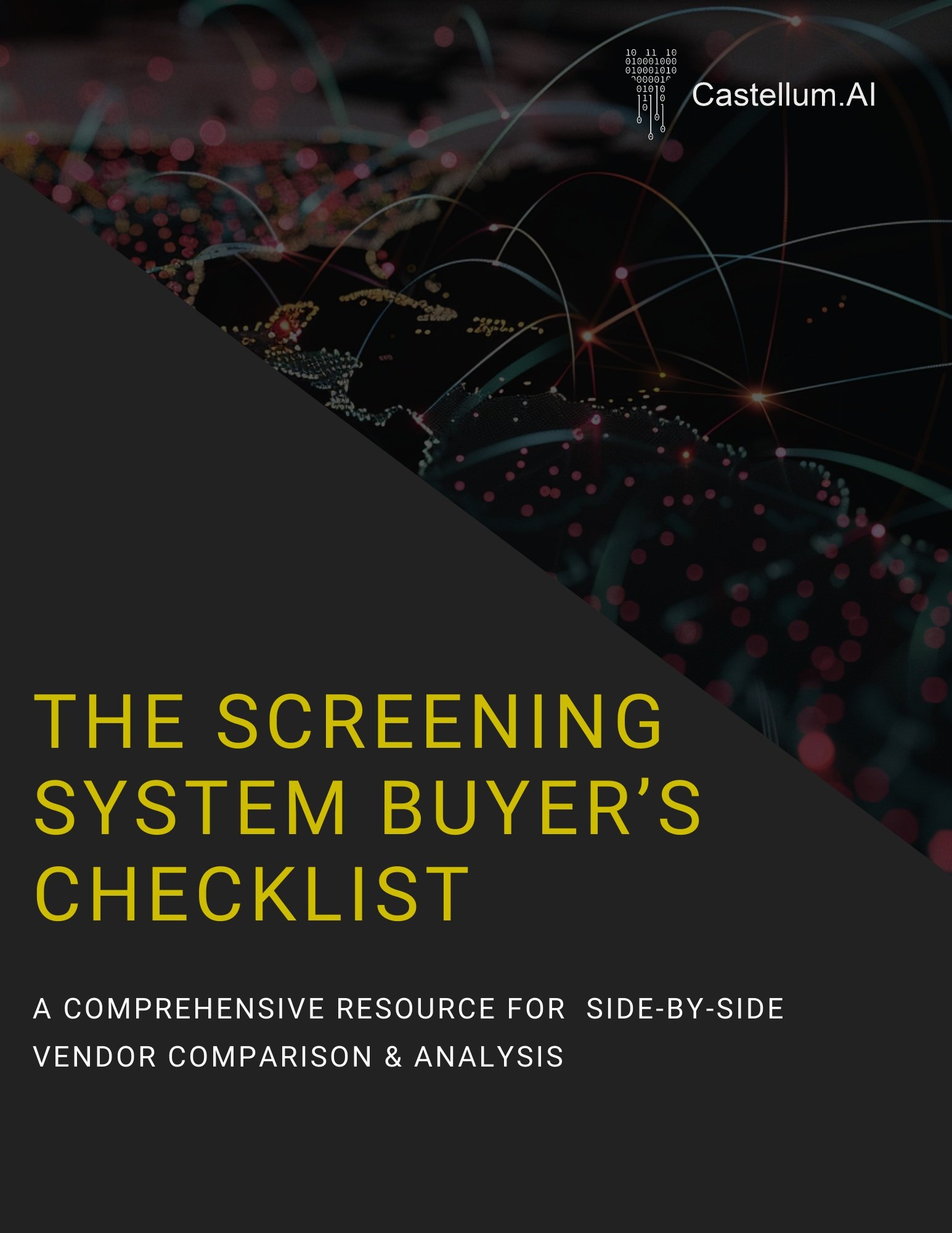Chapter 2: Core Data and Features
Selecting a screening system with the right data and features is essential to an effective, efficient compliance program. In this chapter, we’ll introduce you to the coverage any screening system should have.
Data Integration: Streamlining for Efficiency
A screening system should seamlessly integrate diverse data sets accessible through a single API call. Whenever possible, consolidate data sources into a unified system to simplify the process, and proactively reduce the time and resources spent on data management.
Real-Time Updates
Your system needs to be fast to reflect the latest changes in sanctions, watchlists and regulatory requirements as quickly as possible. For reference, at Castellum.AI we update our database every five minutes.
Question for vendors:
How quickly is your data updated?
Does it update multiple times daily?
If not, is the delay greater than 24 hours for financial crime data?
Is your data update process fully automated or does it rely on analysts to collect and standardize it? '
Data Enrichments
A screening system shouldn’t only collect risk data and present it to its users – standardization and enrichment are essential to improve screening system accuracy. For example, sanctions, PEPs or export control information is issued globally in different languages, structures and data formats. Unenriched data prohibits users from screening against relevant information accurately, increasing the rate of false positives and risk of false negatives, leading to violations.
Castellum.AI’s patent-pending data process automatically collects, standardizes and enriches data from watchlist issuing authorities globally, every five minutes. We extract information from unstructured text like dates of birth, IDs, locations, and more, enabling users to screen financial crime risk accurately and eliminate false positives.
Questions for vendors:
Do you enrich watchlist data?
Do you have examples of your data schema available?
Are data enrichments automated or do analysts enrich manually?
Comprehensive Data Coverage
Your system must cover broad data types for thorough compliance checks. This includes up-to-date information from global sanctions lists, politically exposed persons lists, export control watchlists, and other regulatory databases. Your coverage should extend to all relevant jurisdictions and risk data types to align with your organization’s unique risk profile, international operations or exposure to foreign transactions and trade.
Note: The below risk data categories are comprehensive, use this list to identify your prospective screening systems’ baseline coverage and make note of datasets relevant to your needs.
-
Vital for ensuring compliance with international legal standards. Sanctions lists include global data on entities, individuals, crypto addresses, or assets like vessels and aircraft subject to restrictions, helping to prevent transactions that may violate anti-terrorism or trade regulations.
-
Information about individuals in prominent public positions is used to assess potential corruption and money laundering risks. While doing business with PEPs is not restricted, due to their position they present an elevated money laundering risk and enhanced due diligence is often required.
-
This includes negative news derived from media sources, regulatory publications, law enforcement press releases and other public sources indicating that a potential customer or business counterparty presents a financial crime risk. Including adverse media screening is essential for proactively identifying financial crime and operational and reputational risk that is otherwise unavailable on watchlists.
-
Detailed information regarding true ownership of business entities and ownership networks is necessary to identify whether a company is directly or indirectly linked to sanctions, export controls or other restrictions. This data enables organizations to identify hidden risks in complex corporate structures and comply with regulatory requirements like the OFAC 50% Rule (or similar regulations in the EU and UK) stipulating that an entity is subject to sanctions if they are 50% or more owned by sanctioned parties.
-
Data regarding entities and countries subject to export controls is necessary for adherence to international trade laws and to avoid penalties associated with illegal exports.
-
Data for detecting risks linked to shelf companies that purposefully generate historical operational and transaction records to avoid scrutiny and enable potential illicit transactions like money laundering. This specialized database aids compliance teams and investigators in identifying high-risk entities.
-
Information sourced from global law enforcement databases, including lists of criminals wanted for crimes ranging from fraud to murder to terrorism. Screening customers and counterparties against these databases is essential to ensure an organization is not subject to regulatory and reputational risk.
-
Data on entities barred from entering into contracts, especially with government bodies, due to fraud, non-performance, embezzlement, corruption or other issues. Screening this information enables organizations to avoid reputational and operational risk.
-
Data on entities that have faced regulatory enforcement actions or have been delisted from official records. This data is essential for avoiding engagements with non-compliant or risky entities or individuals.
Beyond the Basics:
Critical System Features
Now that we’ve set a baseline for data coverage, we’ll move on to the foundational features a tier-one screening system provides to enhance your compliance strategy.
🧪 Adjustable Scoring: Tailor screening thresholds to ensure alerts align with your organization’s risk profile.
📉 False Positive Reduction: Accurate matching algorithms minimize unnecessary alerts, saving time and resources.
🔧 Tuning and Filters: Calibrate your screening queries to meet your regulatory requirements.
Minimize false positives
Select relevant data sources
Adjust parameters
🗄 Audit Trails: Maintain logs for regulatory reviews and audits.
📑 Public Documentation: Access to detailed documentation presented to regulators and auditors for compliance verification.
🧹 Data Enrichment: An automatic process to clean and standardize data ingested from source lists. This allows you to search against structured data instead of unstructured watchlist text.
🏟 High Capacity: Hundreds of screenings can be performed with a single API call, each with its own parameters.
🏜 Sandbox Environment: Test and refine your screening processes in a controlled setting without affecting live data. We’ll cover comprehensive testing later on in Chapter 4.
This is a lot to remember, but we’ve got you covered. Download our screening system buyer’s checklist to keep track of it all when you’re assessing vendors.


